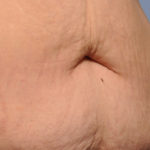The belly button, also known as the umbilicus, is a funnel-shaped scar located in the midline of the abdomen usually about 2/3s the distance between the chest and the pubic region. It is, of course, the remnant of where the umbilical cord was attached to the newborn. It is the only topographic aesthetic feature on an otherwise flat or round abdominal wall. While it has great variability in size and shape amongst humans, an inverted appearance that is not too large is desired.
In a tummy tuck, making a ‘new’ belly button is the last portion of the operation. It is new only from the perspective that it requires a skin incision through the abdominal skin flap which has been stretched down. The original stalk of the belly button is the same, its exit out through the skin is new. While a relatively small procedure in comparison to the scope of the overall tummy tuck, it is an important aesthetic feature that many patients may use to pass judgement on the results of their surgery.

One of the keys to accomplishing some of these tummy tuck belly button goals is fascial suture fixation. Permanent sutures are placedat various locations around the belly button from the underside of its skin to the underside of the abdominal skin and then down to the abdominal fascia. By tying these sutures down, the entire belly button area (and central abdominal region) is pulled inward creating a funnel or ‘drain in the center of the floor’ effect.
These fascial sutures also distribute the pressure on all sides of the belly button and give it a more pleasing shape. The location of these sutures also creates a vertical shape by being placed at the 12, 4 and 8 o’clock positions. This creates a favorable contour feature of the abdomen and pulls the circular belly button scars inward to a more hidden location.
While the re-creation of a belly button is the smallest portion of performing a tummy tuck, it requires finesse and attention to some details to get more than just a round ‘mushroom’ of an umbilical result. These same belly button surgery principles can be applied to revisions of a prior unsatisfactory tummy tuck result as well.
Dr. Barry Eppley
Indianapolis, Indiana



